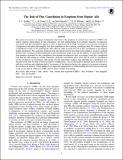The role of flux cancellation in eruptions from bipolar ARs
Abstract
The physical processes or trigger mechanisms that lead to the eruption of coronal mass ejections (CMEs), the largest eruptive phenomenon in the heliosphere, are still undetermined. Low-altitude magnetic reconnection associated with flux cancellation appears to play an important role in CME occurrence as it can form an eruptive configuration and reduce the magnetic flux that contributes to the overlying, stabilizing field. We conduct the first comprehensive study of 20 small bipolar ARs (ARs) in order to probe the role of flux cancellation as an eruption trigger mechanism. We categorize eruptions from the bipolar regions into three types related to location, and find that the type of eruption produced depends on the evolutionary stage of the AR. In addition, we find that ARs that form eruptive structures by flux cancellation (low-altitude reconnection) had, on average, lower flux cancellation rates than the AR sample as a whole. Therefore, while flux cancellation plays a key role, by itself it is insufficient for the production of an eruption. The results provide supporting evidence that although flux cancellation in a sheared arcade may be able to build an eruptive configuration, a successful eruption depends upon the removal of sufficient overlying and stabilizing field. Convergence of the bipole polarities also appears to be present in regions that produce an eruption. These findings have important implications for understanding the physical processes that occur on our Sun in relation to CMEs and for space weather forecasting.
Citation
Yardley , S L , Green , L M , Driel-Gesztelyi , L V , Williams , D R & Mackay , D H 2018 , ' The role of flux cancellation in eruptions from bipolar ARs ' , Astrophysical Journal , vol. 866 , no. 1 , 8 . https://doi.org/10.3847/1538-4357/aade4a
Publication
Astrophysical Journal
Status
Peer reviewed
ISSN
0004-637XType
Journal article
Collections
Items in the St Andrews Research Repository are protected by copyright, with all rights reserved, unless otherwise indicated.

